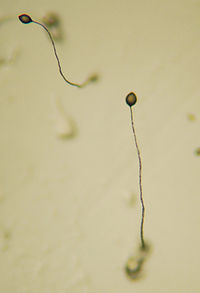
Photo from wikipedia
Abstract G-quadruplexes (G4) are non-canonical DNA and/or RNA secondary structures formed in guanine-rich regions. Given their over-representation in specific regions in the genome such as promoters and telomeres, they are… Click to show full abstract
Abstract G-quadruplexes (G4) are non-canonical DNA and/or RNA secondary structures formed in guanine-rich regions. Given their over-representation in specific regions in the genome such as promoters and telomeres, they are likely to play important roles in key processes such as transcription, replication or RNA maturation. Putative G4-forming sequences (G4FS) have been reported in humans, yeast, bacteria, viruses and many organisms. Here we present the first mapping of G-quadruplex sequences in Dictyostelium discoideum, the social amoeba. ‘Dicty’ is an ameboid protozoan with a small (34 Mb) and extremely AT rich genome (78%). As a consequence, very few G4-prone motifs are expected. An in silico analysis of the Dictyostelium genome with the G4Hunter software detected 249–1055 G4-prone motifs, depending on G4Hunter chosen threshold. Interestingly, despite an even lower GC content (as compared to the whole Dicty genome), the density of G4 motifs in Dictyostelium promoters and introns is significantly higher than in the rest of the genome. Fourteen selected sequences located in important genes were characterized by a combination of biophysical and biochemical techniques. Our data show that these sequences form highly stable G4 structures under physiological conditions. Five Dictyostelium genes containing G4-prone motifs in their promoters were studied for the effect of a new G4-binding porphyrin derivative on their expression. Our results demonstrated that the new ligand significantly decreased their expression. Overall, our results constitute the first step to adopt Dictyostelium discoideum as a ‘G4-poor’ model for studies on G-quadruplexes.
Journal Title: Nucleic Acids Research
Year Published: 2019
Link to full text (if available)
Share on Social Media: Sign Up to like & get
recommendations!